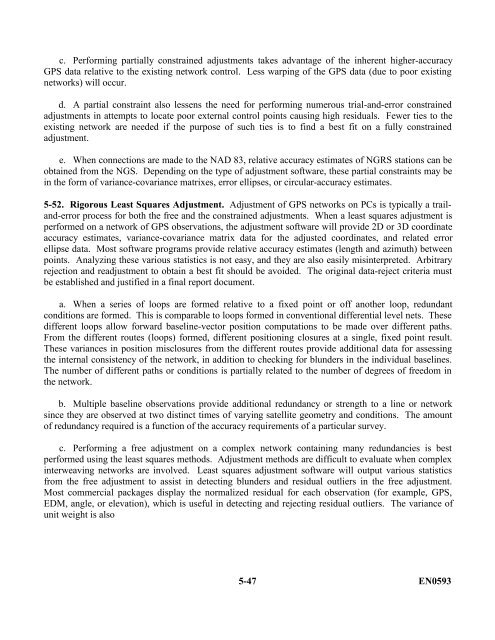surveying iii (topographic and geodetic surveys) - Modern Prepper
surveying iii (topographic and geodetic surveys) - Modern Prepper
surveying iii (topographic and geodetic surveys) - Modern Prepper
Create successful ePaper yourself
Turn your PDF publications into a flip-book with our unique Google optimized e-Paper software.
c. Performing partially constrained adjustments takes advantage of the inherent higher-accuracyGPS data relative to the existing network control. Less warping of the GPS data (due to poor existingnetworks) will occur.d. A partial constraint also lessens the need for performing numerous trial-<strong>and</strong>-error constrainedadjustments in attempts to locate poor external control points causing high residuals. Fewer ties to theexisting network are needed if the purpose of such ties is to find a best fit on a fully constrainedadjustment.e. When connections are made to the NAD 83, relative accuracy estimates of NGRS stations can beobtained from the NGS. Depending on the type of adjustment software, these partial constraints may bein the form of variance-covariance matrixes, error ellipses, or circular-accuracy estimates.5-52. Rigorous Least Squares Adjustment. Adjustment of GPS networks on PCs is typically a trail<strong>and</strong>-errorprocess for both the free <strong>and</strong> the constrained adjustments. When a least squares adjustment isperformed on a network of GPS observations, the adjustment software will provide 2D or 3D coordinateaccuracy estimates, variance-covariance matrix data for the adjusted coordinates, <strong>and</strong> related errorellipse data. Most software programs provide relative accuracy estimates (length <strong>and</strong> azimuth) betweenpoints. Analyzing these various statistics is not easy, <strong>and</strong> they are also easily misinterpreted. Arbitraryrejection <strong>and</strong> readjustment to obtain a best fit should be avoided. The original data-reject criteria mustbe established <strong>and</strong> justified in a final report document.a. When a series of loops are formed relative to a fixed point or off another loop, redundantconditions are formed. This is comparable to loops formed in conventional differential level nets. Thesedifferent loops allow forward baseline-vector position computations to be made over different paths.From the different routes (loops) formed, different positioning closures at a single, fixed point result.These variances in position misclosures from the different routes provide additional data for assessingthe internal consistency of the network, in addition to checking for blunders in the individual baselines.The number of different paths or conditions is partially related to the number of degrees of freedom inthe network.b. Multiple baseline observations provide additional redundancy or strength to a line or networksince they are observed at two distinct times of varying satellite geometry <strong>and</strong> conditions. The amountof redundancy required is a function of the accuracy requirements of a particular survey.c. Performing a free adjustment on a complex network containing many redundancies is bestperformed using the least squares methods. Adjustment methods are difficult to evaluate when complexinterweaving networks are involved. Least squares adjustment software will output various statisticsfrom the free adjustment to assist in detecting blunders <strong>and</strong> residual outliers in the free adjustment.Most commercial packages display the normalized residual for each observation (for example, GPS,EDM, angle, or elevation), which is useful in detecting <strong>and</strong> rejecting residual outliers. The variance ofunit weight is also5-47 EN0593
















